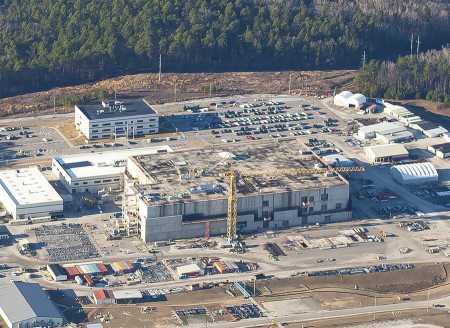MOX Facility to Switch to Plutonium Pits
June 2018
By Kingston Reif
The Trump administration is ending a costly, controversial project intended to convert surplus plutonium into power reactor fuel and is proposing to re-engineer the partially constructed facility in South Carolina to provide a second source for plutonium cores for nuclear weapons.
But significant questions remain about whether Congress will back the plan, as well as about the affordability and necessity of the Trump administration’s envisioned production increase for plutonium cores, known as pits, the primary component of nuclear weapons.
 Energy Secretary Rick Perry submitted a certification to Congress in May that will allow the semiautonomous National Nuclear Security Administration (NNSA) to formally end construction of the mixed-oxide (MOX) fuel fabrication facility at the Energy Department’s Savannah River Site in South Carolina in favor of a cheaper alternative.
Energy Secretary Rick Perry submitted a certification to Congress in May that will allow the semiautonomous National Nuclear Security Administration (NNSA) to formally end construction of the mixed-oxide (MOX) fuel fabrication facility at the Energy Department’s Savannah River Site in South Carolina in favor of a cheaper alternative.
Further, the NNSA and Defense Department announced that the half-built facility will be repurposed for pit production, a move likely designed in part to soften the blow to South Carolina from ending the MOX fuel project.
“We are extremely disappointed to hear the Department of Energy plans to abandon the MOX program,” the majority of South Carolina’s congressional delegation said in a May 10 statement. “[T]he MOX program—which is one of the most important nonproliferation programs in the history of the world—is being abandoned without any clear path forward.”
The statement was signed by the state’s two Republican senators, Lindsey Graham and Tim Scott, and five of its seven members of the House of Representatives. Although the lawmakers expressed support for the opportunity to host the production of plutonium pits at Savannah River, they warned that the department “will encounter a skeptical Congress and American public on any proposal” for a new mission at the site.
The MOX fuel plant, designed to turn 34 metric tons of surplus plutonium from the U.S. nuclear weapons program into power reactor fuel, was plagued by major cost increases and schedule delays. The Energy Department has sought to end the program since 2014 in favor of a cheaper alternative, known as “dilute and dispose.” That process would down-blend the plutonium with an inert material for direct disposal at the deep underground Waste Isolation Pilot Plant in New Mexico.
Congress, led by South Carolina’s congressional delegation, blocked the department’s effort to transition to the alternate approach. But the fiscal year 2018 National Defense Authorization Act, signed by President Donald Trump last November, included a provision allowing the energy secretary to stop construction if there is a cheaper alternative to dispose of the plutonium at “less than approximately half of the estimated remaining [life-cycle] cost” of the MOX fuel program. (See ACT, May 2018.)
According to a report prepared by the NNSA’s independent cost office, certified by Perry, and submitted to Congress on May 10, the dilute-and-dispose process would cost at most $19.9 billion, 40 percent of $49.4 billion cost of continuing the MOX fuel program. The agency is preparing a second, more comprehensive cost analysis planned for release in June or July.
Perry’s certification coincided with the release of a joint statement from NNSA and Defense Department officials announcing that the MOX fuel facility would join Los Alamos National Laboratory in New Mexico in the production of at least 80 pits per year by 2030.
“This two-prong approach—with at least 50 pits per year produced at Savannah River and at least 30 pits per year at Los Alamos—is the best way to manage the cost, schedule, and risk of such a vital undertaking,” the statement said.
The plan, which would involve a smaller production role for Los Alamos than previously expected, lacked such key specifics as the estimated cost to repurpose the MOX fuel facility and produce the pits there.
Safety problems at Los Alamos forced the lab to stop production of plutonium pits from 2013 to 2016. (See ACT, July/August 2017.) Concerns about the safety of plutonium operations at Savannah River also have been documented in recent internal government reports, according to reporting last month by the Center for Public Integrity.
The Trump administration’s report on its Nuclear Posture Review, unveiled Feb. 2, calls for laying the groundwork to provide “capabilities needed to quickly produce new or additional weapons” beyond the 3,800 warheads currently in the active U.S. nuclear stockpile. (See ACT, March 2018.)
One measure of the scale of the plan for building “new or additional weapons” is given in the report’s commitment to “[p]rovide the enduring capability and capacity to produce plutonium pits at a rate of no fewer than 80 pits per year by 2030.” No basis is offered for this minimum capacity target.
In a May 10 statement, four of the five members of New Mexico’s congressional delegation, including Democratic Sens. Tom Udall and Martin Heinrich, criticized the proposal to split the plutonium-production mission between Los Alamos and Savannah River.
“Instead of wasting billions of dollars exploring the construction of a new facility that will likely never be completed somewhere else, the Department of Energy should immediately move forward with the new, modular plutonium facilities at Los Alamos—as originally endorsed by both Congress and the Nuclear Weapons Council,” they said in their statement.
Other critics of the new plan argue that there is no need to expand plutonium pit production and that the NNSA can use pits from dismantled weapons if more are needed to sustain
the arsenal.
“There is no explanation why the Department of Defense requires at least 80 pits per year, and no justification to the American taxpayer why the enormous expense of expanded production is necessary,” Jay Coghlan, the director of Nuclear Watch New Mexico, said in a May 10 press release.
